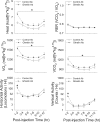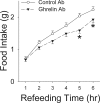Catalytic antibody degradation of ghrelin increases whole-body metabolic rate and reduces refeeding in fasting mice
- PMID: 18981425
- PMCID: PMC2582297
- DOI: 10.1073/pnas.0711808105
Catalytic antibody degradation of ghrelin increases whole-body metabolic rate and reduces refeeding in fasting mice
Abstract
Obesity is a chronic, costly, and globally prevalent condition, with excess caloric intake a suspected etiologic factor. Nonsurgical treatments are modestly efficacious, and weight loss maintenance is hampered by anti-famine homeostatic mechanisms. Ghrelin, a gastric hormone linked to meal initiation, energy expenditure, and fuel partitioning, is hypothesized to facilitate weight gain and impede weight loss. Unique among known animal peptides, the serine-3 residue of ghrelin is posttranslationally acylated with an n-octanoic acid, a modification important for the peptide's active blood-brain transport and growth hormone secretagogue receptor-1 agonist activity. Pharmacological degradation of ghrelin would be hypothesized to reduce ghrelin's biological effects. To study endogenous ghrelin's role in appetite and energy expenditure, we generated antibodies that hydrolyze the octanoyl moiety of ghrelin to form des-acyl ghrelin. The most proficient antibody catalyst, GHR-11E11, was found to display a second-order rate constant of 18 M(-1) x s(-1) for the hydrolysis of ghrelin to des-acyl ghrelin. I.v. administration of GHR-11E11 (50 mg/kg) maintained a greater metabolic rate in fasting C57BL/6J mice as compared with mice receiving a control antibody and suppressed 6-h refeeding after 24 h of food deprivation. Indirect respiratory measures of metabolism after refeeding and relative fuel substrate utilization were unaffected. The results support the hypothesis that acylated ghrelin stimulates appetite and curbs energy expenditure during deficient energy intake, whereas des-acyl ghrelin does not potently share these functions. Catalytic anti-ghrelin antibodies might thereby adjunctively aid consolidation of caloric restriction-induced weight loss and might also be therapeutically relevant to Prader-Willi syndrome, characterized after infancy by hyperghrelinemia, hyperphagia, and obesity.
Conflict of interest statement
The authors declare no conflict of interest.
Figures





References
-
- Yach D, Stuckler D, Brownell KD. Epidemiologic and economic consequences of the global epidemics of obesity and diabetes. Nat Med. 2006;12:62–66. - PubMed
-
- Allison DB, Fontaine KR, Manson JE, Stevens J, VanItallie TB. Annual deaths attributable to obesity in the United States. Jama. 1999;282:1530–1538. - PubMed
-
- Kojima M, et al. Ghrelin is a growth-hormone-releasing acylated peptide from stomach. Nature. 1999;402:656–660. - PubMed
-
- Mori K, et al. Kidney produces a novel acylated peptide, ghrelin. FEBS Lett. 2000;486:213–216. - PubMed
-
- Tena-Sempere M, et al. Novel expression and functional role of ghrelin in rat testis. Endocrinology. 2002;143:717–725. - PubMed
Publication types
MeSH terms
Substances
Grants and funding
LinkOut - more resources
Full Text Sources
Other Literature Sources
Medical
Molecular Biology Databases

